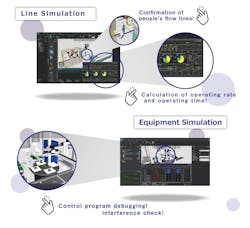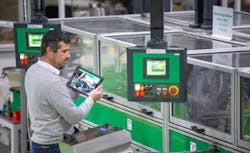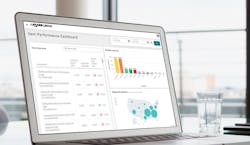1. Automotive
According to ABI Research, the automotive sector is the biggest spender on digital transformation, spending $100 billion in 2022. One of the biggest reasons for this is that OEMs and their suppliers needed to adjust for the move away from the Internal Combustion Engine to electric power trains.
The U.S. government is one of many that have created required targets for electric vehicles to be the norm by 2035.
The switch to EVs requires OEMs to turn to software to design these new types of vehicles and work with parts suppliers to ensure components meet performance requirements as well as sustainability regulations and initiatives. These investments in industrial design platforms will be critical as design teams devise new components for the age of EVs.
Additionally, current production lines will have to be transitioned to accommodate these new types of vehicles without creating downtimes and choking production volume.
An example of one of these design platforms is Mitsubishi's MELSOFT Gemini 3D Simulator Software. The simulator models machines and manufacturing processes virtually to allow users to visualize projects and reduce risk by validating designs in advance, expediting the design and construction as new automation components are introduced to the facility.
Gemini operates using a PC-based 3D digital space and connects directly to factory devices without having to go through an OPC server, enabling 3D data to be updated faster in digital spaces.
Engineers can test and debug automation logic for machines and systems, as well as check the operation of the planned production prior to construction. As projects advance, they can quickly identify the causes of abnormal occurrences in the production line using logged data to step through and review the error event on the 3D model, PLC sequence monitor, waveform display, and/or video data.
In addition to these new software requirements, MES and MOM developers have taken to updating their solutions to accommodate this changing landscape.
For example, Panasonic's PanaCIM Enterprise Edition MES is an electronics assembly software that provides advanced levels of integration across a company's entire enterprise. It includes workflows for production analysis, production planning, production monitoring and dispatch, material verification, traceability, material control, product changeover and control, maintenance, and enterprise link.
Its real-time data monitoring identifies events such as part exhausts, changeovers, and process shifts. It dispatches tasks to the necessary labor resources via email, PDA or visual display allowing the operator to take ownership with auto-detection of event resolution. It also generates reports for analysis of event history by product, operator, and equipment.
Additionally, the system allows for accurate cost estimations, line configurations best suited for future needs, and material availability management including control of excess WIP raw materials on the production floor.
2. Electronics & Technology
Electronic gadgets are growing every day and won't stop anytime soon. Manufacturers of electronics produce millions of items to increasingly precise standards.
These standards are moving beyond the capabilities of humans on a production line and creating the need for more sophisticated avenues such as automation, with machine learning and robots being top players.
Semiconductor manufacturers have already largely removed humans from the entire production process and have become an example of the lights-out manufacturing concept. Recently, there's been a large push for reshoring facilities and production back to our home soil creating a real-estate frenzy for these facility locations. Spending on digital technologies for this sector is forecast to surpass $130 billion in 2030, up from $95 billion this year according to ABI Research.
The IRB 1010 industrial robot is ABB's smallest ever robot that was designed to meet the growing demand for wearable smart devices. Its compact size, payload, and accuracy offer electronics manufacturers the opportunity to increase their production of devices by increasing the number of cells that can be fit into production spaces.
The IRB 1010 has the ability to lift up to three times more weight than comparable robots and coupled with a larger diameter air hose that provides added power for vacuum suction, it enables simultaneous handling of multiple objects, allowing more objects to be processed per hour.
Machine Learning (ML) solutions are also becoming more common as they can provide excellent quality assurance, even as automation speeds ramp up.
Dataprophet PRESCRIBE uses advanced predictive and prescriptive ML capabilities to predict defects, faults, and quality errors, and prescribe optimum control parameters to improve production. The solution, which is already in use in multiple Tier 1 U.S. automotive suppliers, can be integrated into existing data environments in as little as four to eight weeks.
PRESCRIBE ingests and analyzes process and quality control information from databases, spreadsheets, streaming sensors, and PLC sources, and can record up to 1,000 data points a second. State-of-the-art ML models are able to learn from this data to identify optimal control bounds.
To enable process change, the system provides operators with an easy-to-use web interface that helps them identify when operational parameters have exceeded the target control bounds and prioritize the changes required to optimize production and reduce scrap.
Access to the web interface can be closely controlled, limiting features, reports, and parameter access accordingly; while client manufacturing and application data are housed in a fully isolated database for maximum security.
Users can compare reports across different time periods to see if process changes are being handled correctly, as well as explore reports across different steps in the process. Users are also able to filter uncontrollable and optimized parameters to focus on critical changes that need to be made and search for parameters crucial to a particular piece of equipment or process change.
3. Oil & Gas
The oil & gas industry remains in flux due to economic conditions around the world. Producers use digital technologies to monitor their operations to ensure they get the maximum yield from each location. However, the industry is something of a pariah, so it must invest in technologies to monitor emissions and conditions in the local area.
All parts of the value chain are prioritizing investments in cybersecurity following the cyberattack on the Colonial Pipeline. The challenges mean that suppliers must increase their spending on digital technology by a CAGR of 5.8% (2022 to 2030), reaching $15.4 billion in 2030, according to ABI Research.
EcoStruxure Plant Performance Advisors suite from Schneider Electric helps enterprises leverage their automation data to increase profitability.
The suite of smart manufacturing apps and digital services provides easy-to-understand real-time analytics for quick decision-making. The modular and scalable approach to implementation makes it cost-effective for plants to quickly turn the volumes of data they produce into the actionable insights they need to reach high levels of operational efficiency, profitability, and sustainability.
EcoStruxure collects, measures, and analyzes the information and recommends the actions to take for continuous improvement. The suite features fully configurable, off-the-shelf solutions for easy integration into even the most advanced systems. By providing users with a familiar application theme and environment, an efficient plant can create synergies for processes and empower digital operators.
Schneider Electric’s modular and scalable EcoStruxure Plant Advisors suite includes:
- EcoStruxure Pumping Performance Advisor is a digital service for the continuous improvement of water and wastewater pumping assets in 24/7 operations.
- EcoStruxure Equipment Efficiency Advisor provides real-time efficiency root cause analysis. It then recommends appropriate action plans for increasing capacity while reducing unscheduled downtime and waste.
- EcoStruxure Augmented Operator Advisor uses AR to slash the amount of time a worker spends looking for information to about a tenth of current levels. By superimposing real-time data and virtual objects onto cabinets or machines, this “contactless maintenance” model also increases safety. EcoStruxure Augmented Operator Advisor V2.4 is easy to customize; no special platform knowledge is required. Users can also easily add augmented reality into existing procedures and export notes and analyses to share with others.
- EcoStruxure Secure Connect Advisor with embedded cybersecurity provides a digitally secure and simple asset monitoring connection for remote diagnostics and maintenance that reduces plant downtime while saving time and travel costs to maintain critical assets.
We're also seeing Investments in software that enable operators to simulate production flows or simulate the operation of an entire facility. In addition to predictive maintenance, operators will look to data analytics to help them optimize production in line with price fluctuations. Due to solutions of these types, fewer staff are required on oil rigs, as more processes can be automated and monitored from afar.
Honeywell's HALO Operator Advisor enables plant owners to measure gaps and drive operator effectiveness by presenting users with a consolidated scorecard of enterprise automation utilization and recommended steps to address performance-related gaps.
The solution uses ML to gather insights from data sources such as distributed control systems and funnel those insights into dashboards. These dashboards then showcase a clear and complete view of operator performance and improvement opportunities. By understanding how actions, inactions, and workload levels contribute to optimal production, organizations can develop targeted training programs, make strides toward autonomous operations, and build process resilience.
4. Fast-Moving Consumer Goods
Manufacturers of consumer goods are under pressure from every angle. The cost of raw materials and ingredients continues to rise, but retailers often refuse to accept price increases; that assumes the producer has a supply chain that delivers all the ingredients when required. In addition, firms are under pressure from an ESG perspective to adjust their packaging and use less water in their operations.
Technology has a role to play in
Meeting these challenges requires technology, whether that's supply chain visibility and forecasting or packaging redesigns. But manufacturers are especially concerned that their recipes do not fall into the wrong hands and, similar to oil & gas firms, continue to prioritize spending on cybersecurity. ABI Research has forecasted total spending on digitalization will reach $23.8 billion in 2030 (a 15% CAGR).
The octoplant software platform from Auvesy helps reduce production downtime and provides protection against data loss through a vendor-independent backup and cyber security strategy. The data management platform provides a view of all automation backup processes involving OT and IT, and users are protected against production downtime and data loss.
octoplant consists of eight function sets tailored to different industrial needs and uses dashboards to display the various statuses of the plant. It displays the status of all machine programming as well as the version history of all changes with detailed visibility into program differences through tabular and graphical reports.
Production managers can benefit from knowing where programs and configurations are stored and how up-to-date they are with the touch of a button. They can take quick and decisive action in the event of system failure or when production comes to a standstill by restarting production and restoring the previous settings with automatic program backups; this can apply to a single device or the entire plant.
Additionally, manufacturers will need a digital thread for visibility on both raw material availability and potential demand from consumers to stay on top of production. This is where supply chain data becomes very handy and very important.
An example of an advanced supply chain analytics platform, RJW Logistics Group's Edge Insights quickly delivers data that drives better decision-making and total supply chain control, helping with inventory management and performance forecasting.
Customized analytics capabilities include demand forecasting, item performance, item cost and trends, inventory management optimization, retailer analytics, and OTIF, among others. This information is aggregated and delivered through easy-to-understand illustrations and trend graphs.
Lastly, manufacturers are looking to technology suppliers to help them be more sustainable by using less water in their facilities and wasting fewer resources in their operations.
Connected Components Workbench software version 20.01 from Rockwell Automation helps simplify the development of standalone machines that are built with Rockwell Automation's Micro Control System.
This latest release eases configuration and addresses more water/wastewater application requirements with the expanded DNP3 and DF1 support, including half-duplex and radio modem modes. It also improves system security through a password set/verify and user project encryption/decryption in the plug-in memory module.
About the Author
Laura Davis
Editor-in-Chief, New Equipment Digest
Laura Davis is the editor in chief of New Equipment Digest (NED), a brand part of the Manufacturing Group at EndeavorB2B. NED covers all products, equipment, solutions, and technology related to the broad scope of manufacturing, from mops and buckets to robots and automation. Laura has been a manufacturing product writer for eight years, knowledgeable about the ins and outs of the industry, along with what readers are looking for when wanting to learn about the latest products on the market.






